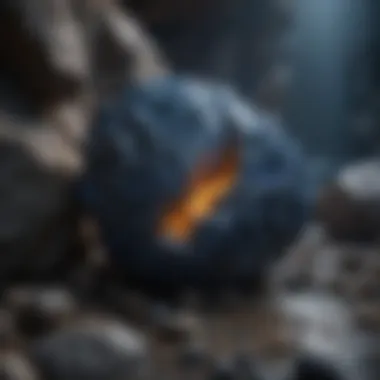Unveiling the Mysteries of the Enigmatic Dark Blue Rock: A Comprehensive Exploration


Rock and Fossil Identification
When delving into the intriguing realm of dark blue rocks, understanding rock and fossil identification becomes paramount. Different types of rocks and fossils manifest varied characteristics that are essential to recognize. From the texture to the color saturation, each aspect offers clues for identification. To aid in this process, utilizing tools such as magnifying glasses, UV lights, and hardness testing kits can illuminate distinct features.
Collecting Tips and Techniques
Embarking on a journey to collect dark blue rocks necessitates adherence to best practices. Ensuring ethical collecting practices and obtaining necessary permits are fundamental. Locating prime collecting sites often involves intense research and exploration. Once at the site, safely extracting specimens without causing harm to oneself or the environment is crucial. Employing tools like chisels, hammers, and protective gear can enhance the collecting experience.
Preservation and Display
After acquiring dark blue rocks, preserving them for longevity becomes imperative. Utilizing techniques such as cleaning, drying, and sealing helps maintain their pristine condition. Proper storage methods involve keeping rocks in a cool, dry place to prevent deterioration. When it comes to display, exploring creative ideas like shadow boxes, lighted shelves, or themed arrangements can showcase the beauty of dark blue rocks magnificently.
Geological Insights
Unveiling the geological insights behind dark blue rocks unveils a fascinating narrative of Earth's history. Understanding the formations and processes that lead to the creation of these rocks provides deep insights. Delving into the historical significance and notable discoveries in the field uncovers layers of knowledge that enrich the appreciation for dark blue rocks. From ancient seabeds to volcanic eruptions, each geological aspect contributes to the allure of these enigmatic treasures.
Introduction
In embarking on the exploration of dark blue rocks, we are venturing into a realm of geologic intrigue and esoteric allure. These enigmatic stones, with their deep blue hues reminiscent of the night sky, hold within them a tapestry of mysteries waiting to be unraveled. The significance of this topic goes beyond mere geological interest; it strikes at the very core of human fascination with the Earth's hidden treasures. By delving into the origins, properties, and cultural significance of dark blue rocks, we not only enrich our understanding of the natural world but also glimpse into the depths of history and human interaction with these captivating minerals.


Dark blue rocks stand as a testament to the geological forces that have shaped our planet over millennia. From the intricate processes that led to their formation to the unique compositions that give them their distinctive colors, these rocks offer a window into Earth's complex and ever-evolving story. By studying their physical characteristics and chemical makeup, we can unlock valuable insights into the forces at play deep within the Earth's crust.
Moreover, the identification methods used to distinguish one type of dark blue rock from another are as diverse as the rocks themselves. From subtle variations in color and texture to specialized tests that reveal their compositional secrets, the journey of unraveling the mysteries of dark blue rocks is both a scientific endeavor and an artistic pursuit. As we navigate through the world of these alluring minerals, we are confronted with the challenge of accurately discerning their subtle differences and understanding the implications of their unique features.
In the pages that follow, we will delve into the depths of understanding dark blue rocks, peeling back the layers of history, science, and culture that surround these captivating gems. With each revelation comes a new appreciation for the complexities of the natural world and the profound beauty hidden within the seemingly ordinary rocks beneath our feet.
Understanding Dark Blue Rocks
Origins of Dark Blue Rocks
Delving into the origins of dark blue rocks unveils a fascinating journey through geological timescales. These rocks, formed deep within the Earth's crust over millions of years, carry within them the stories of ancient tectonic movements and mineral transformations. Understanding the origins of dark blue rocks not only provides a historical context but also sheds light on the intricate processes that crafted these exceptional geological specimens.
Geological Significance
The geological significance of dark blue rocks lies in their composition and formation processes. These rocks, often characterized by high concentrations of specific minerals, offer valuable insights into past environmental conditions and geological events. By studying the geological significance of dark blue rocks, researchers and collectors alike can piece together the puzzle of Earth's intricate geological history, unraveling mysteries hidden within the depths of these captivating specimens.
Identification Methods
Identifying dark blue rocks requires a meticulous approach and a keen eye for detail. From visual characteristics to chemical composition analysis, a variety of methods can be employed to determine the exact nature of these mysterious rocks. Understanding the different identification methods not only aids in correctly categorizing dark blue rocks but also enhances the appreciation of their diverse forms and structures.
Properties of Dark Blue Rocks


\nDark blue rocks exhibit a fascinating array of properties that intrigue collectors and geologists alike. Their unique combination of physical characteristics, chemical composition, and distinct features sets them apart from other minerals. \n \nUnderstanding the properties of dark blue rocks is crucial for enthusiasts looking to identify, collect, and appreciate these stunning geological wonders. By delving into their properties, one can uncover valuable insights into their formation processes, geological significance, and aesthetic appeal. \n \nThe physical characteristics of dark blue rocks play a pivotal role in distinguishing one type from another. These rocks can vary in hardness, density, luster, and crystal structure, offering a diverse range of textures and appearances. Observing their physical properties under different lighting conditions can reveal intricate patterns, color variations, and inclusions that add to their visual allure. \n \nOn the other hand, the chemical composition of dark blue rocks provides essential clues about their formation history and mineral content. Analyzing elements such as silica, alumina, and various trace minerals helps researchers classify these rocks into specific mineral groups. The presence of distinct chemical compounds contributes to their coloration, stability, and overall crystalline structure, shedding light on their geological origins. \n \nMoreover, dark blue rocks boast unique features that set them apart from other minerals. From phosphorescence and fluorescence under ultraviolet light to distinctive cleavage patterns and inclusions, these rocks exhibit a mesmerizing array of characteristics. Studying their unique attributes not only aids in identification but also enhances appreciation for the natural forces that shaped them over millennia. \n \nIn conclusion, the properties of dark blue rocks encompass a diverse range of physical, chemical, and distinctive features that make them a captivating subject of study for collectors and scientists alike. By exploring these properties in depth, one can gain a deeper appreciation for the enigmatic world of dark blue rocks and the hidden secrets they hold within their crystalline structures.
Popular Varieties of Dark Blue Rocks
Dark blue rocks come in various fascinating varieties, each with its unique characteristics and allure that captivate rock and fossil collectors worldwide. Understanding the distinctions among these popular varieties is crucial for enthusiasts seeking to expand their collections and deepen their appreciation of the enigmatic world of dark blue rocks.
Lapis Lazuli
Lapis Lazuli, one of the most renowned dark blue rocks, has a rich history dating back centuries and holds significant cultural and artistic value. Its deep blue hue, often interspersed with golden pyrite flecks, adds to its splendor and appeal to collectors. Noteworthy for its use in jewelry and artistic masterpieces throughout history, lapis lazuli continues to mesmerize with its bold color and striking presence. Geological enthusiasts are drawn to its diverse patterns and shades, making it a prized addition to any collection.
Azurite
Azurite, characterized by its intense azure-blue color, is prized for its stunning aesthetic appeal and metaphysical properties. This dark blue rock's deep coloration results from its copper content, giving it a captivating look that ranges from vibrant blue to subtle azure tones. Collectors value azurite for its association with intuition, wisdom, and intellectual pursuits. Its distinct crystal formations and intricate patterns make each specimen a unique treasure, sought after by those fascinated by its metaphysical significance.
Sodalite
Sodalite, a dark blue rock known for its rich royal-blue hue interspersed with white calcite veins, exudes elegance and charm. Its striking coloration and unique veining patterns make sodalite a sought-after gemstone for both collectors and artisans. With its associations with logic, truth, and clear communication, sodalite appeals to individuals seeking mental clarity and emotional balance. Whether admired in its raw form or transformed into ornamental pieces, sodalite continues to captivate with its beauty and metaphysical properties.
Collecting and Preserving Dark Blue Rocks
Exploring the enigmatic realm of dark blue rocks goes beyond mere appreciation of their beauty; it entails the meticulous task of collecting and preserving these geological treasures. The section on 'Collecting and Preserving Dark Blue Rocks' in this comprehensive guide serves as a vital cornerstone for rock and fossil enthusiasts. With a keen focus on the specific elements, benefits, and considerations surrounding the acquisition and conservation of dark blue rocks, this segment aims to equip collectors with the necessary knowledge and practices to uphold the integrity and value of their specimens.


Best Practices for Collection
Delving into the best practices for collecting dark blue rocks uncovers a plethora of essential procedures that ensure the acquisition of high-quality specimens. From identifying prime locations for sourcing these rocks to employing appropriate tools for extraction, this subsection provides invaluable insights into optimizing the collection process. Emphasizing techniques to ethically gather specimens without harming their natural environment, collectors are guided on sustainable approaches that contribute to the preservation of geological heritage.
Preservation Techniques
Preserving the pristine condition of dark blue rocks demands specialized techniques to maintain their visual appeal and structural integrity. This section elucidates various preservation methods, such as cleaning, stabilizing, and protecting against environmental factors. By exploring the intricate procedures involved in safeguarding these rocks from degradation or damage, collectors can prolong the longevity of their specimens while retaining their intrinsic value and aesthetic allure.
Storage Recommendations
The final facet of ensuring the longevity and quality of dark blue rocks lies in appropriate storage practices. From controlling humidity levels to shielding specimens from light exposure, this subsection offers detailed recommendations on creating optimal storage conditions. By understanding the significance of proper storage in preventing deterioration or discoloration, collectors can safeguard their prized dark blue rocks for future generations to appreciate.
Unique Uses of Dark Blue Rocks
Dark blue rocks hold a significant place in various facets of human history, thanks to their unique properties and aesthetic appeal. In the world of art and jewelry, dark blue rocks like Lapis Lazuli have been cherished for centuries due to their vivid coloration and exquisite veins. The intricate patterns within these rocks have inspired masterpieces and adorned the crowns of royalty, symbolizing power and prestige.
Furthermore, dark blue rocks play a crucial role in spiritual practices and healing therapies. Many cultures believe that these rocks possess mystical energies that can alleviate stress, enhance focus, and promote tranquility. From ancient civilizations to modern holistic medicine, the legacy of dark blue rocks as metaphysical aids continues to intrigue and captivate believers around the globe.
Notably, dark blue rocks are also utilized in modern technology, particularly in the field of semiconductors and optics. The unique chemical composition of these rocks makes them valuable in the manufacturing of components for electronic devices and precision instruments. Their contribution to innovation and advancement showcases the versatile nature of dark blue rocks beyond their ornamental and spiritual significance.
Historical and Cultural Significance
Delving into the historical and cultural tapestry of dark blue rocks unveils a rich narrative that spans across civilizations and epochs. In ancient Egypt, Lapis Lazuli was revered as a symbol of royalty and divine connection, often found in burial chambers and amulets to guide souls to the afterlife. The mesmerizing hue of these rocks symbolized the vast and eternal sky, embodying a sense of cosmic harmony and spiritual enlightenment.
Similarly, in Renaissance Europe, dark blue rocks gained popularity among renowned artists such as Michelangelo and Vermeer, who recognized their unparalleled beauty and symbolic value. From religious icons to regal jewelry, the presence of dark blue rocks in prestigious artworks mirrored the elite status they held in society, signifying opulence and sophistication.
Moreover, across diverse cultures globally, dark blue rocks are embedded in folklore and traditions, believed to bring luck, protection, and wisdom to those who possess them. From Native American rituals to Asian spiritual practices, the reverence for these rocks transcends geographical boundaries, emphasizing their enduring influence and significance in human civilization.







